Blog: Making Money From Wholesale Selling on Amazon
Making Money From Wholesale Selling on Amazon
There's not so much information to be found on the internet about Wholesale Selling on Amazon. The interesting stuff that you do tend to find is debate over whether or not wholesale on Amazon is a profitable business venture.
The main questions I hear on the topic include:
- How does it work?
- How is it different to the private label model?
- Can you build a profitable business with wholesale on Amazon?
- How do you identify products with wholesale potential?
- What do you do when you find those products?
This post is going to explore the above questions in detail, ultimately to highlight that with the correct research and preparation, wholesale selling on Amazon is still a viable business option.
Webinar
Back in September 2016 we hosted a really insightful webinar with wholesale expert Dan Meadors from The Wholesale Formula.
If you have some time (1 hour and 12 minutes of it), you can watch the replay here. I wanted to retrospectively share the key points Dan made as well as my own learnings and thoughts on the subject here in this post.
Wholesale on Amazon – How does it work?
Selling wholesale on Amazon is a model which means you purchase items directly from the manufacturer and then sell them as a reseller on Amazon, to consumers.
This means you are not launching a new brand, creating new listings or trying to add value to a product within a niche where there is opportunity. Instead you are buying products from established brands, and selling them as a reseller on the Amazon marketplace.
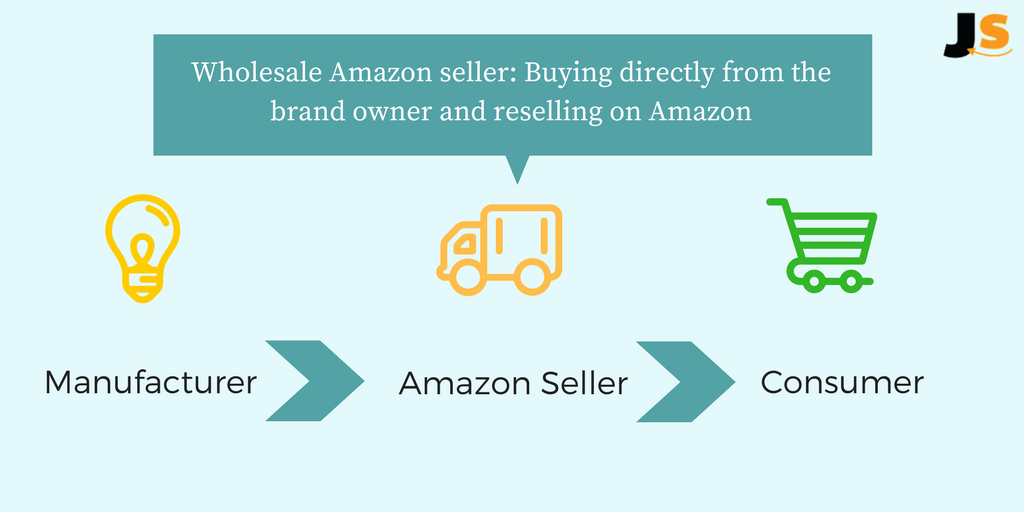
Generally this requires having a wholesale license*, and over time, building up strong relationships by exercising your buying and selling power to manufacturers. Many wholesale businesses will focus a lot of energy on sourcing and forming these relationships, in order to scale the business.
*Make sure you look into what the wholesale license requirements are in your country or state.
So why bother selling products that already have an established brand? Well there are pros and cons to all business models. Let's take a look at how this model differs from the other two popular ones, retail arbitrage and private label.
How does wholesale differ from retail arbitrage?
Retail arbitrage requires a lot of time and physical effort to source the products you are going to sell on Amazon. It's still a viable business option, but it's not as scalable because of the time and effort required to be out there on the streets finding products. Even online arbitrage is time consuming, despite cutting out the amount of travelling you might be required to do.
There are plenty of successful wholesale sellers as well as private label sellers who started out with retail arbitrage once upon a time. But guess what? The successful ones mainly moved on to a new business model.
How does wholesale differ from private label?
Just like with retail arbitrage, private label has a different set of advantages and requirements compared to wholesale.
The main difference between private label and wholesale is that when you contact a manufacturer as a private label seller, you are looking for an appropriate manufacturer to make your product idea. Plus you are usually trying to improve or add to a product that already exists. You then buy the inventory from your chosen manufacturer and send it to Amazon's warehouse.
With wholesale, you are looking to contact the manufacturer as the brand owner. For example, if you tried to sell Samsung smart phones that you sourced from a supplier in China, but did not source from the brand owner (Samsung), you would be selling counterfeit items. Not cool!
Many private label sellers usually utilize Amazon's fulfillment services. Whereas with the wholesale business model, you can often find sellers both using FBA or managing the warehousing and distribution themselves.
Wholesale Pros & Cons
So to summarize some of the pros of building a wholesale business on Amazon:
- Scalable growth opportunity
- No need to build a listing or a brand from scratch
- You can build a team and free up your own time as a business owner
- Stay in control of your business in terms of warehousing, packing and shipping if you want to (which means you can control your expenses)
- But, you can still do Amazon FBA too!
- Pricing from the manufacturer does not fluctuate too much, so there is less of a race to the bottom for the buy box (compared to arbitrage)
- You get to work with some big brands
Note: some of the above are true of the private label model, too!
And here's some of the roadblocks that you might encounter:
- Finding manufacturers (brand owners) who aren't already selling directly through Amazon
- Exercising your buying and selling power as a new business – getting approved for wholesale accounts
- Costs to acquire and set up your own warehouse if this is the route you take
- Low margin products
- Super high order quantities
How to identify products with wholesale potential?
When sourcing wholesale products you want to find products that:
- Have an established brand history
- Are not sold by Amazon
- Are not a private label product
- Have a high monthly sales velocity
So you are looking for products that will sell, that you can go back to the manufacturer and reorder more stock as needed, and of course, you don't want to be selling product that is at the end of it's lifecycle.
Dan shared his process for this which goes a little something like this:
- Find product opportunities on Amazon
- Google the manufacturer
- Contact the manufacturer
- Be prepared to negotiate
Sourcing – Starting on Amazon
You can start by investigating niches, competitors and browsing in the Amazon categories and sub-categories.
Similar to starting up your product research for private labelling, you just need to dive in and not be afraid to dig around. The main thing is that you need to keep your criteria in mind, so you know when you find something that might carry opportunity. You also need a way to uncover estimated monthly sales, which is going to be really powerful in getting you all of the data you need to make smart purchasing decisions.
Don't forget you can also use the Product Estimator tool, plus BSR to get estimated Amazon sales for free.
Example
Let's just run through the process once using some product brands that Dan touched on within the webinar: Vitamins. Dan's thought processes on wholesale product research were super transparent and really insightful so all credit to him.
Here is the page for vitamin products by the brand LivOn. Using the Jungle Scout Pro Extension we can immediately pick out a product with 3,388 estimated monthly sales:
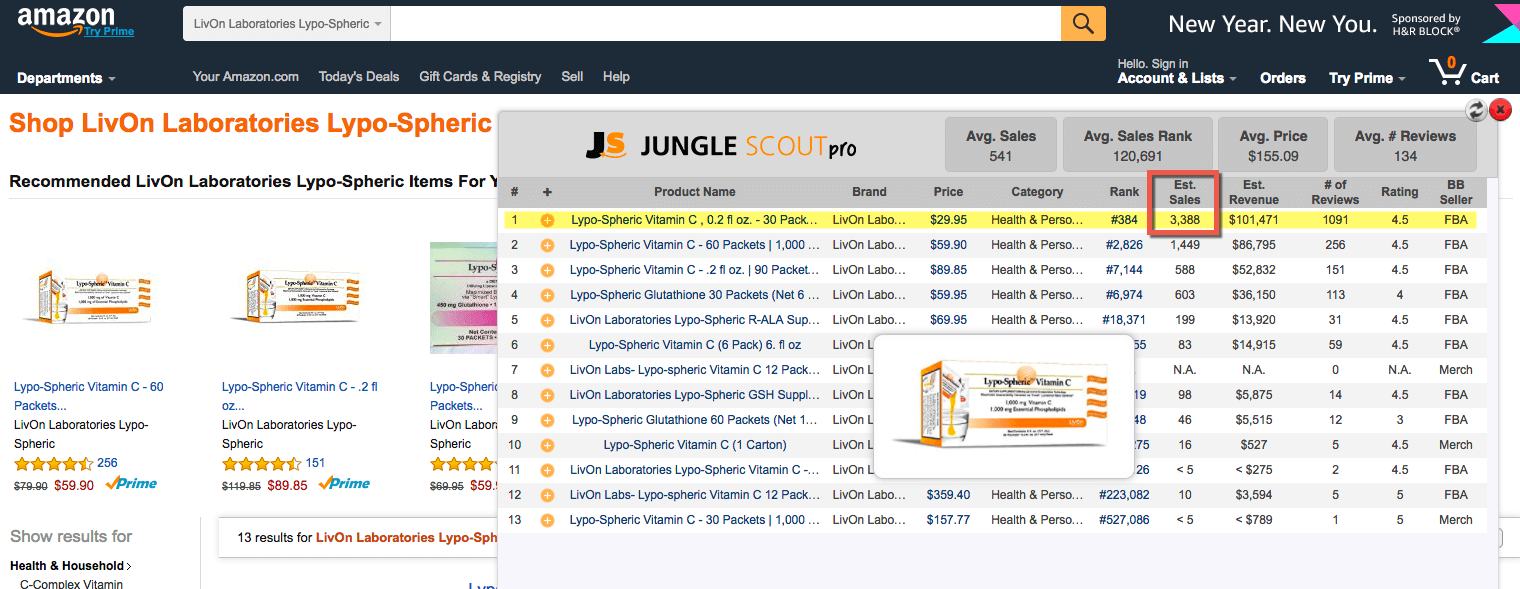
So next if we click into this product, we can check out how many other sellers are selling it:
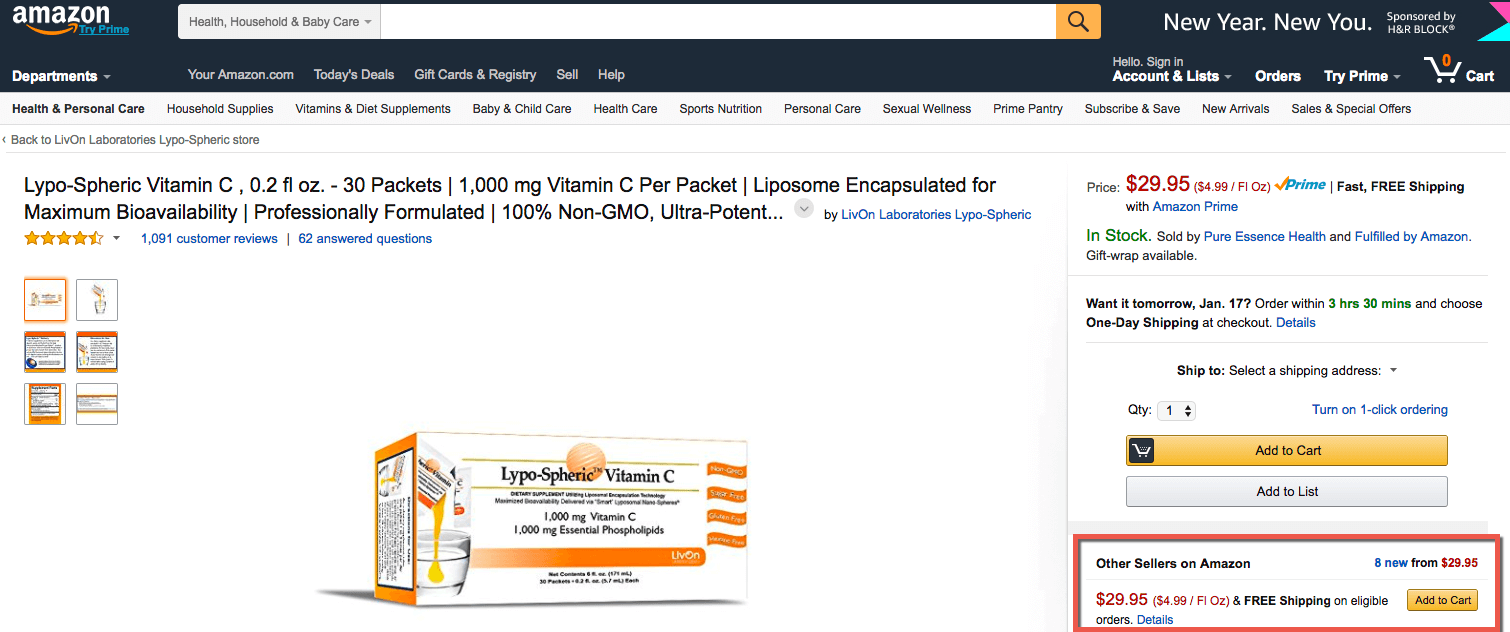
We can see that there are 8 sellers on Amazon, but we want to know how many competitive sellers there are. Dan's method was to find out how many sellers are selling at 2% within the buy box (the lowest Amazon Prime price).
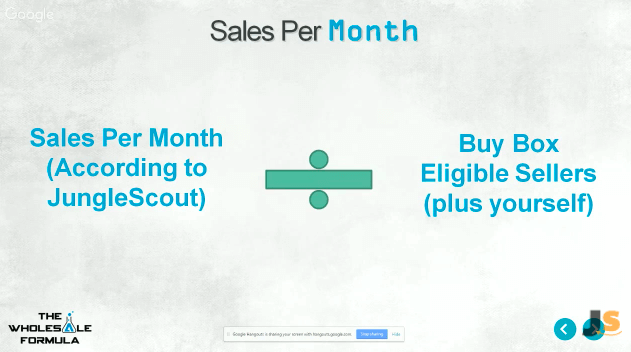
So using this logic, let's take a look at the sellers of the LivOn Vitamin C:
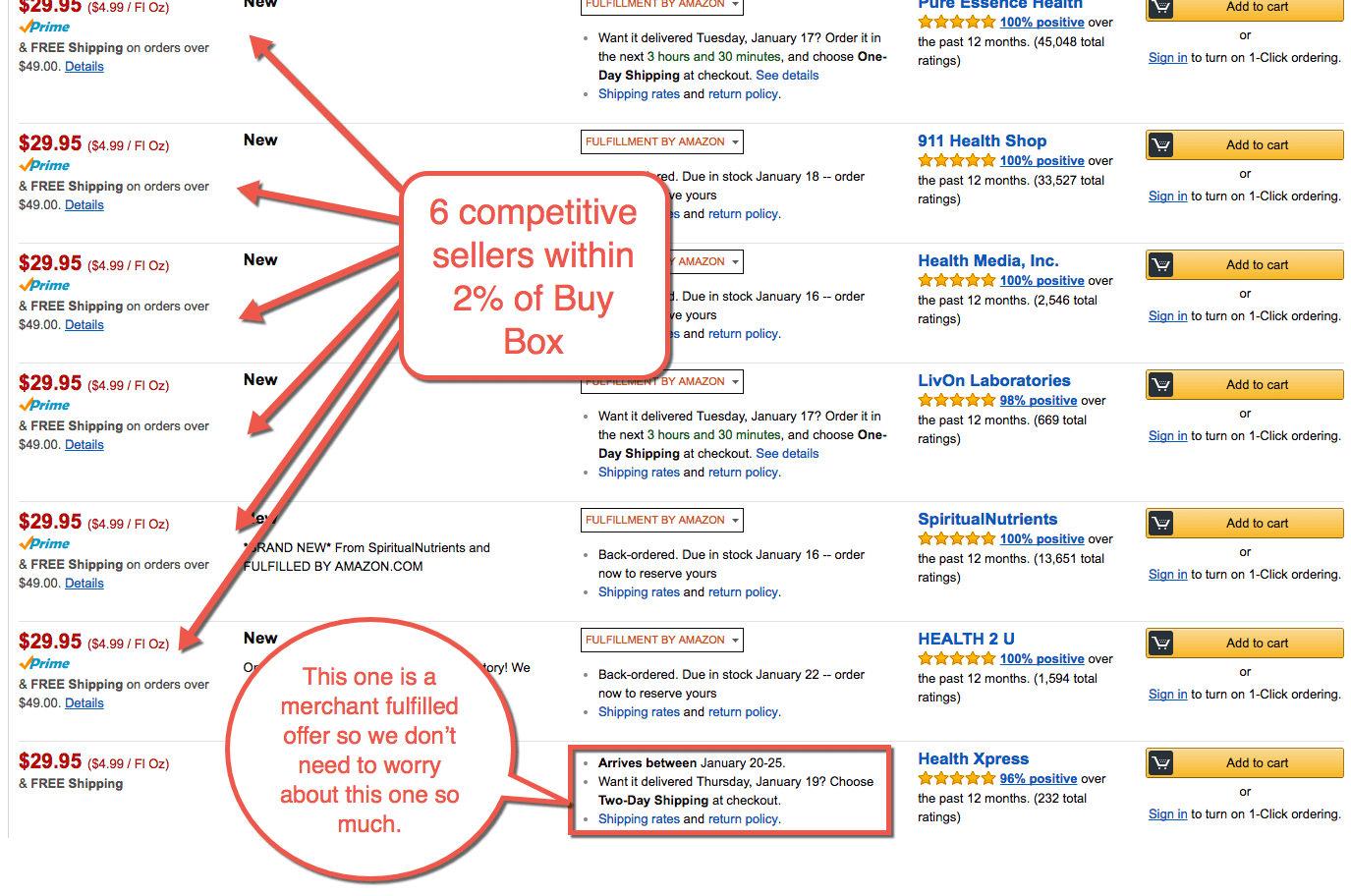
With this particular product you can see everyone is selling at the same price. Sometimes, brands and manufacturers might specify that resellers have to sell their products at a particular price. This isn't something to worry about necessarily, as we will discover in a moment.
Calculating estimated monthly sales
Let's pretend there is a range of prices here. We would want to do a calculation to find out how many sellers are within the 2% competitive range. So in this case, it would be 29.95 x 1.02% = $30.54. So any sellers above $30.54 are not considered competitive.
Once you have the number of competitive sellers, you can take this divide by the estimated monthly sales. But don’t forget to add yourself.
Your expected monthly sales = (Competitive Sellers + Yourself) / Estimated Monthly Sales
In this example there are 6 competitive sellers (because they're all selling at $29.95) and potentially me. So I can take the estimated monthly sales we found earlier, 3,388 and divide this by 7. The scores on the doors? 484 estimated sales per month.
That's pretty good going. Even if I was a newer seller and got less cycles in the buy box, I can still expect to take a portion of the equity. So even though all sellers are using the same listing price, there are still enough monthly sales for me to come in and take some profits.
Decision time!
In this case I will add this product to my list of potential and consider contacting LivOn to become an approved reseller.
As soon as you get into serious talks with a manufacturer, you will be able to figure out your profit margins and thus, your estimated profits based on these estimated sales and your expenses.
TIP: Don’t forget to weed out any products where Amazon are selling the product, or where there is a private label seller
The key thing to remember here is, don't be put off by a high number of sellers of a product – it's more about finding products where there is enough monthly sales and few enough competitive sellers, for you to enter the marketplace with this product.
Next steps – Contacting & Negotiating With Manufacturers
We already have the brand name from our previous research on Amazon. As mentioned before, a quick Google should land you the manufacturer / brand contact details.
The next step is to get approved and set up an account with manufacturer. Here's some top tips we discussed in the webinar on how you can negotiate:
- Show how you can add value to the brand
- Identify any problems that you can help with them
- Show examples of how you can make their products sell better
- Look for brands who aren't interested in selling their products on Amazon themselves
- Let them know that you aren’t as stringent as Amazon and ultimately, you will be easier to work with
- Make sure you let them know any additional benefits you can add, such as product photography
- If they come back with a resounding “no” at first, that doesn't mean it's the end.
Remember that these manufacturers are big companies concerned with new product development, patents, global marketing initiatives and so on. So you have a fantastic advantage to negotiate with here. You can help them with selling on Amazon, because they don't have the time or know-how to do it themselves.
You are extending their brand and increasing their sales. They don't have to do much work in order for you to do that. This is your advantage.
Inventory Management
Similar to selling with a private label model, or indeed for most and any ecommerce sellers, it's very important to manage inventory effectively.
Even if you are housing inventory in your own warehouse, you want to keep costs to a minimum, and you want to stock the right amount. Not too much and not too little.
This is another reason why your research during sourcing is so important. In figuring out your average monthly sales you can start to estimate your stock requirements, even before you have sales history of that particular product.
What if I am starting a new business?
If you are considering becoming a wholesale Amazon seller, remember all sellers have to start somewhere. Try not to worry about a lack of sales history or profile strength. Even when you are less competitive on that buy box, if you get your research right and start selling products, you will be moving forwards.
As you are growing and scaling upwards you will still be getting sales. Even if your share of it is less than your competitors, until you build a stronger profile. All businesses have to go through the initial growth period and this is just something you need to be prepared for and mindful of.
For example, when you are in the sourcing phase, factor this in to your product research. If you see there are large sellers within 2% of the buy box, you can make a decision based on how competitive it is and how much equity you would get as a relatively new seller. You may want to exclude potential products from your selection process at this stage (but be sure to save them as ideas for later).
Conclusion
Wholesale selling on Amazon is definitely a viable business model that has a lot of potential. The key to success is knowing how to do your research right, getting really good at negotiating with manufacturers and building up a strong profile on Amazon.
I personally chose the private label route, so maybe I am a little biased because it is how I built my own business on Amazon. But listening to Dan's genius insights on the webinar we did together really made me see Wholesale in a new light. Inspiring stuff!
What are your thoughts? Are you a wholesale seller or looking to become one? Let us know in the comments?
